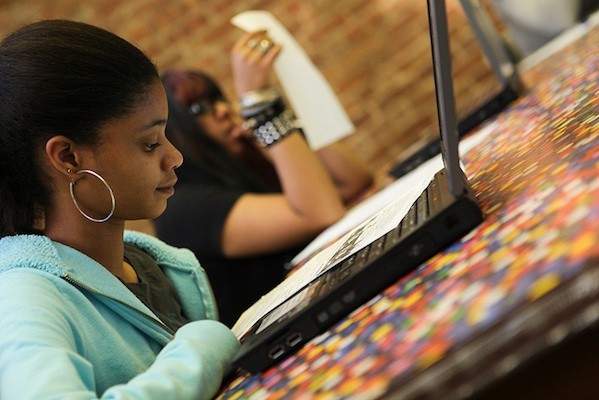Share, Grow, Do: The Potential of Digital Age Learning

The National Writing Project has launched a fantastic new web site, Digital Is, to build a community amongst educators exploring how the digital age is changing how we write, share, collaborate, publish and participate in the digital age. More importantly, what does this mean for the teaching of writing? The site offers resources, news and discussions. It is fairly new, so check it out and consider being part of building this community. Global Kids has already contributed to Digital Is by adding multimedia curriculum for Supporting Youth to Develop a Mental Map of Where They Learn.
Other choice resources we've discovered recently and been inspired by:
The Lessons of Lucasfilm's Habitat (paper)
"Cyberspace may indeed change humanity, but only if it begins with humanity as it really is.” This was written back in 1990, before the invention of the World Wide Web, analyzing “Habitat,” a mid-80s video game that was the first commercial, large-scale, graphically-based online community and a forerunner of the modern virtual world. For those interested in virtual worlds and learning, it is enlightening to go back and read this paper by game developers Chip Morningstar and F. Randall Farmer, who share such insights as: "We feel that the defining characteristic of cyberspace is the sharedness of the virtual environment, and not the display technology used to transport users into that environment. Such a cyberspace is feasible today, if you can live without head-mounted displays and other expensive graphics hardware...Finally, we have come to believe that the most significant challenge for cyberspace developers is to come to grips with the problems of world creation and management." Leveraging the “sharedness” of virtual worlds is something that might have begun with Habitat but it is still being explored by educators today.
“Faster and Fancier Books”: Mapping the Gaps Between Expert and Public Understandings of Digital Media and Learning (report)
“Faster...” is a fascinating and comprehensive study of the gap between common perceptions of digital media’s role in and impact on education voiced by those outside of education as contrasted with the understandings of experts in the field of digital media and learning. It reads like research from a spin doctor for a political candidate -- what to say and in what order -- but is designed for those interested in advocating for learning through digital media. With a particular focus on the false conceptual divide between scholastic and informal learning, this study suggests that comprehensive digital media programs face more than just logistical and technical barriers to reaching classrooms. Prevailing skepticism and fears about digital media lead to negative preconceptions for many, even as experts and the public alike acknowledge the power of active, hands-on learning experiences in the classroom. The report also presents practical suggestions for re-framing discussions of digital media learning to overcome dogma and common misperceptions -- while encouraging a more progressive view of educators as mentors and collaborative facilitators of student-driven and self-motivated learning.
DigitalLiteracy.gov (website)
After you finish mining Digital Is, check out the fresh-out-of-the-oven DigitalLiteracy.gov. The site is designed to “allow practitioners in service-oriented organizations—such as libraries, schools, community centers, community colleges, and workforce training centers—to find digital literacy content.” Educators can search by specific literacy, such as “Internet collaboration” or “content evaluation” or by topic, such as “copyright” or “child online protection.” Perhaps what is most interesting about this site is its producer: the Obama administration. The Digital Literacy portal is “an initiative of the Obama Administration to serve as a valuable resource to practitioners who are delivering digital literacy training and services in their communities.”
How Advertisers Use Internet Cookies to Track You (video)
In this Webby Award-winning video by The Wall Street Journal, animation and a simple narration are used to explain how advertisers use cookies to track your online habits. The video provides an easy-to-understand explanation, making it very conducive to sharing it with students who may not be familiar with behavioral targeting and its connection to advertising. The topics addressed can also lead to powerful discussions with students about online privacy.
The Art of Immersion: How the Digital Generation Is Remaking Hollywood, Madison Avenue, and the Way We Tell Stories (interview)
Participatory culture scholar Henry Jenkins interviews Wired contributing editor Frank Rose on his new book, The Art of Immersion. The book offers a timely exploration of how “transmedia” is radically changing the way entertainment and media is experienced and produced. Rose tracks the ways that, as networked communication brings fan communities together with each other as well as with commercial media producers, new and immersive modes of collaborative play and storytelling are becoming ubiquitous, overtaking the “passive” mode of media consumption. Drawing on examples as disparate as the open-ended plot of Lost and the impact of gaming on the storytelling structure of Inception, Rose offers a glimpse into a possible, not-too-distant future of our new relationship with mass media.
Global Kids does an awesome job each month flagging relevant resources for us. Please please share what you're reading and watching, too. Global Kids' NYC-based programs address the need for young people to possess leadership skills and an understanding of complex global issues to succeed in the 21st century workplace and participate in the democratic process.
Banner image credit: holy meatballs http://www.flickr.com/photos/holymeatballs/4503382752/in/set-72157623805364590